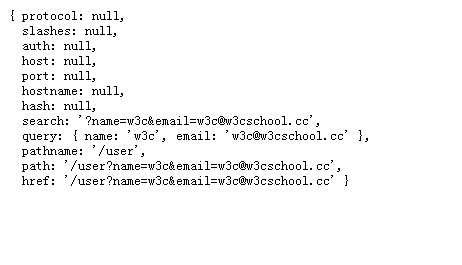Node.js GET/POST请求
Posted
tags:
篇首语:本文由小常识网(cha138.com)小编为大家整理,主要介绍了Node.js GET/POST请求相关的知识,希望对你有一定的参考价值。
在很多场景中,我们的服务器都需要跟用户的浏览器打交道,如表单提交。
表单提交到服务器一般都使用GET/POST请求。
本章节我们将为大家介绍 Node.js GET/POST请求。
获取GET请求内容
由于GET请求直接被嵌入在路径中,URL是完整的请求路径,包括了?后面的部分,因此你可以手动解析后面的内容作为GET请求的参数。
node.js中url模块中的parse函数提供了这个功能。
var http = require(‘http‘);
var url = require(‘url‘);
var util = require(‘util‘);
http.createServer(function(req, res){
res.writeHead(200, {‘Content-Type‘: ‘text/plain‘});
res.end(util.inspect(url.parse(req.url, true)));
}).listen(3000);
在浏览器中访问http://localhost:3000/user?name=w3c&[email protected] 然后查看返回结果:

获取POST请求内容
POST请求的内容全部的都在请求体中,http.ServerRequest并没有一个属性内容为请求体,原因是等待请求体传输可能是一件耗时的工作。
比如上传文件,而很多时候我们可能并不需要理会请求体的内容,恶意的POST请求会大大消耗服务器的资源,所有node.js默认是不会解析请求体的, 当你需要的时候,需要手动来做。
var http = require(‘http‘);
var querystring = require(‘querystring‘);
var util = require(‘util‘);
http.createServer(function(req, res){
var post = ‘‘; //定义了一个post变量,用于暂存请求体的信息
req.on(‘data‘, function(chunk){ //通过req的data事件监听函数,每当接受到请求体的数据,就累加到post变量中
post += chunk;
});
req.on(‘end‘, function(){ //在end事件触发后,通过querystring.parse将post解析为真正的POST请求格式,然后向客户端返回。
post = querystring.parse(post);
res.end(util.inspect(post));
});
}).listen(3000);以上是关于Node.js GET/POST请求的主要内容,如果未能解决你的问题,请参考以下文章
Node.js使用superagent模拟GET/POST请求样例